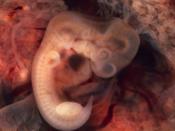Human Cloning Controversial Research Essay | |
� | |
Human Cloning The possibility of human cloning was raised when Scottish scientists, led by Dr. Ian Wilmut at the Roslin Institute, created the much-celebrated sheep "Dolly". Being the first mammal ever cloned this aroused worldwide interest and concern because of its scientific and ethical implications. The feat, cited by "Science Magazine" as the "breakthrough of 1997", also generated uncertainty over the meaning of "cloning" -- an umbrella term traditionally used by scientists to describe different processes for duplicating biological material. Since this creation, mice, goats, cows and pigs have been successfully cloned around the world. This has made human cloning a real possibility. Cloning is the production of one or more individual plants or animals that are genetically identical to another plant or animal. It is different from natural fertilisation which is "sexual" reproduction that occurs when a sperm fertilises an egg. In normal fertilisation the developing embryo (and person) has the genetic makeup or DNA of both parents 23 chromosomes from the female and 23 from the male. The embryo is the unique human organism with a novel genetic makeup having the full potential to develop to adulthood. Current definitions define "embryo" as follows: "the term `human embryo or embryos' includes any organism that is derived by fertilisation, parthenogenesis, cloning, or any other means from one or more human gametes or human diploid cells." Figure 1: Comparing cloned embryos with fertilized embryo's Source: Available from URL: http://www.house.gov/weldon/issues/clone_basics.htm#cloning (Accessed Sunday March 2008) When the media report on cloning in the news, they are usually talking about only one type called reproductive cloning. There are different types of cloning however, and cloning technologies can be used for other purposes besides producing the genetic twin of another organism. A basic understanding of the different types of... |
Human Cloning
More Biology
essays:
Human Cloning
... Scientists control all of the steps of the cloning and the clone has no real decision in anything. They will become almost like a robot of some sort. With all these ideas about human cloning circulating, there is much doubt about having human clones ...
Human Reproductive Cloning Vs. Therapeutic Cloning
... cloning naturally, but there are three different types of human cloning that can occur. One way of cloning is when the human embryo separates in the beginning stages of development. This is how identical twins form. The second type is when human stem cells ...
The History of Cloning
... cloning experiment. They conclude that once mouse embryos reach the two cell stage they cannot be used for cloning. Others confirm their results. 1993- Embryologists at George Washington University cloned human embryos: they took cell groups from 17 human embryos ...
Cloning issue
... Scottish scientists produced the first live birth of a healthy sheep by cloned from an adult sheep. These scientists had established their works by transferring the nuclei from a donor sheep into the egg of another sheep. They scraped skin cells from the udder of a donor sheep and these cells ...
Cloning Research Paper
... Dolly was a clone of the sheep (her genetic mother) who provided the udder cell. The package of genes in the nucleus of that udder cell contained exactly the same repertoire of genes as all the rest of her mother's cells and so Dolly 's genetic makeup ...


